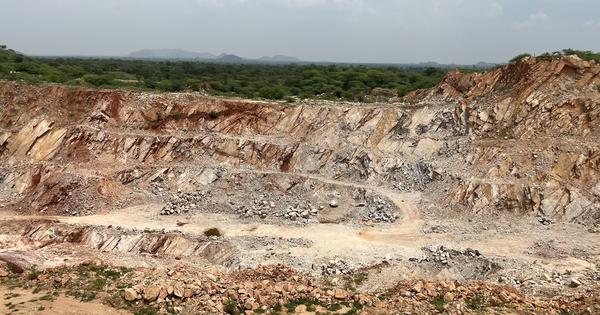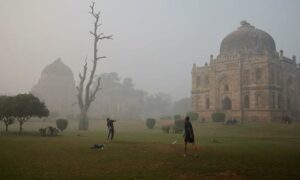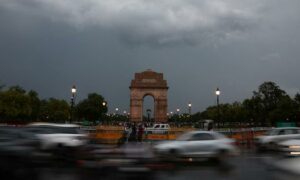
Early in May, a thick cloud of dust swept across the National Capital Region. Flights were delayed and schools were forced to shut. As temperatures breached 45 degrees celsius, the air turned into a blanket of heat and particulate matter. Sudden heavy downpours – more frequent than usual – flooded streets, clogged drains and brought traffic to a standstill.
For many in Delhi, this is beginning to feel routine. These are not isolated weather events but warnings. And one of the most urgent signals is coming from the hills residents barely see anymore: the Aravallis.
Disappearing inch by inch
The two-part Citizens’ Reports, published by the People for Aravallis in May, are an urgent public record of ecological degradation and institutional failure. Rich in maps, satellite imagery, testimonies from the ground, court rulings and scientific documentation, the reports offer not just a critique of state neglect but a clear-eyed account of what we are losing and why.
Several violations have been geo-tagged and catalogued across the seven Aravalli districts in south Haryana. These include new road constructions, forest clearances, illegal encroachments, mining activity and solid waste dumping in areas declared as Natural Conservation Zones that have been designated as such to protect natural features such as hills, rivers and forests.
The mapping includes active violations in Mangar Bani, Anangpur, Bandhwari and Khori Khurd, which are are sacred groves and forest patches within the Aravallis.
Perhaps the most visible symbol of this collapse is the Bandhwari landfill, which, since 2008, has grown into a festering mountain of untreated urban waste on the edge of a forest. Despite being within the Natural Conservation Zone and Aravalli hills, Bandhwari continues to receive waste from Gurgaon and Faridabad every day. The leachate has been seeping into the groundwater. Open burning is a regular occurrence.
In 2019, the Bandhwari landfill, with 35 lakh tonnes of waste, stood taller than the surrounding Aravalli hills. In April 2025, it was reported that the landfill size had reduced to 13 lakh tonnes of waste. In five years from 2020, it seems that 22 lakh tonnes of waste have disappeared. Where has all this waste gone?
Over the last few years, hazardous solid waste from Bandhwari landfill has been dumped in mining quarries and forest areas in various locations in the Aravallis in Gurugram and Faridabad districts, the reports found. These Aravalli areas are lifelines that recharge water in India’s National Capital Region and critical wildlife habitats that should not have any toxic waste in them.
In Mangar Bani in Faridabad district, known for its dense sacred groves, the encroachment has taken another form. Religious structures are springing up on forest land. Real estate projects continue to push boundaries, often in blatant violation of zoning norms. Aerial images show fresh roads carved out through previously intact hill tracts.
The reports also make clear what is at stake. The Aravallis are not an isolated ecosystem. They play a vital role in protecting the Indo-Gangetic plains from the desertification creeping east from the Thar. These hills are a natural barrier for windblown sand, regulate groundwater flows and moderate extreme heat.
In Delhi and its surrounding region, the Aravallis help buffer rising temperatures and stabilise local climate patterns. With each hill quarried and patch of forest cleared, this capacity is eroded.

Governance failures and neglect
If the Aravallis are dying, it is not for lack of knowledge but lack of political will. The Citizens’ Reports lay bare not only the ecological decline but the institutional complicity and bureaucratic indifference that has enabled it. There is no shortage of policies or court rulings. What is missing is enforcement, coordination, and most importantly, commitment.
Across the National Capital Region, the Natural Conservation Zones were established to protect sensitive areas from unregulated development. These were included in the Regional Plan 2021 under the National Capital Region Planning Board. Yet, states like Haryana have repeatedly tried to dilute or bypass these provisions, sometimes by simply not notifying critical zones, or by misclassifying forest land to favour real estate and infrastructure projects.
Another layer of this crisis is the fragmentation of responsibilities. The Forest Department controls one aspect, the Pollution Control Board another, and land-use decisions often rest with revenue or urban development authorities. This allows blame to be shifted endlessly while violations persist. What results is a governance vacuum, a space where private interests flourish and public interest recedes.
Then there’s the political economy. The proximity of the Aravallis to Delhi makes them prime real estate. Quarrying, construction and waste disposal are lucrative businesses. The reports hint at how political patronage and informal networks enable violations to continue despite court orders. Cases linger for years in the National Green Tribunal, which deals with cases related to environmental protection, or the Supreme Court. By the time action is taken, the damage is done.
The lack of credible environmental impact assessments and the weakening of institutions like the environment ministry, the National Green Tribunal and local forest rights committees has further hollowed out the regulatory framework. This is a case of deliberate neglect and a governance system that prioritises short-term profit over long-term ecological security.
Across villages and towns in the Aravalli belt, communities have not stopped fighting. The Citizens’ Reports are testimony to this. Local residents have mapped forest boundaries, documented illegal mining, resisted eviction and filed petitions.
In villages like Mangar, Khori Khurd, Rajawas, Dholera, Ramalwas and many others, citizens have refused to be silenced, even when their own government fails them. But citizen advocacy can only go so far. Without systemic reform in land-use planning, environmental clearance protocols, inter-agency coordination, and judicial follow-through the Aravallis will continue to erode. What is needed is not more paperwork but political courage.
Urgent intervention needed
Reimagining the Aravallis calls for a radical rethinking of urbanisation, not just in Delhi, but in every city creeping into its nearby forests. We must ask: what kind of cities are we building? Can there be an urbanism that listens to the land?
As Delhi reels under heatwaves and water crises, the connection becomes clear. India cannot build climate resilience while destroying its climate buffers. No amount of air-conditioned metro lines or tree-planting drives will make up for the erasure of hill systems that stabilise weather, filter water and breathe life into our settlements.
Reclaiming the Aravallis also means reimagining governance. It means empowering local bodies, especially gram sabhas and urban residents’ groups, to monitor and protect ecologically sensitive areas. It means using citizen science, open data, and community mapping as legitimate tools in environmental decision-making.
But perhaps most urgently, it means shifting the story. From one of ecological neglect to one of collective responsibility. From a politics of extraction to a politics of care. From expert-led declarations to citizen-led action.
The Aravalli Citizens’ Reports in the end demands that Aravallis be declared a “no-go area” for mining, waste dumping, burning, and landfills and enacting a law that makes its destruction an ecological crime.
These are solutions which require political will, only if the governments are willing to listen: not just to facts and figures, but to the sounds of a mountain being broken, to the voices of those who live on its slopes and to the wisdom that comes from knowing that not all progress is growth.
Madhuresh Kumar is with the National Alliance of Peoples’ Movement India and the Global Tapestry of Alternatives.
This article first appeared on Scroll.in
📰 Crime Today News is proudly sponsored by DRYFRUIT & CO – A Brand by eFabby Global LLC
Design & Developed by Yes Mom Hosting






